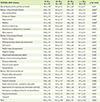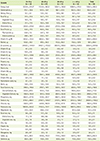1. Lee JH, Kim CK. The effect of the online writing therapy program on self-concept and depression of the adolescents with muscular dystrophy. J Spec Educ Rehabil Sci. 2011; 50:221–242.
2. Johnson EW, Kennedy JH. Comprehensive management of Duchenne muscular dystrophy. Arch Phys Med Rehabil. 1971; 52:110–114.
3. Brooke MH. A clinician's view of neuromuscular diseases. 2nd ed. Baltimore (MD): Williams & Wilkins;1986.
4. Health Insurance Review & Assessment Service (KR). Subcategory disease statistics [Internet]. 2014. cited 2015 December 1. Available from
http://www.hira.or.kr.
5. Lee EJ, Kim YJ, Song NK, Kim EH, Lee SC, Moon JH, Min KS. The correlation of lean body mass with muscle function in duchenne muscular dystrophy. J Korean Acad Rehabil Med. 2003; 27:688–692.
6. Kanda F, Fujii Y, Takahashi K, Fujita T. Dual-energy X-ray absorptiometry in neuromuscular diseases. Muscle Nerve. 1994; 17:431–435.

7. Jung CO, Jung KJ, Choi JH, Park YG, Yoon YH. Nutritional status of Duchenne muscular dystrophy in South Korea. J Korean Assoc EMG Electrodiagn Med. 2011; 13:103–110.

8. Ling CH, de Craen AJ, Slagboom PE, Gunn DA, Stokkel MP, Westendorp RG, Maier AB. Accuracy of direct segmental multi-frequency bioimpedance analysis in the assessment of total body and segmental body composition in middle-aged adult population. Clin Nutr. 2011; 30:610–615.

9. Kim SY. Intracellular to extracellular fluid shifts and changes in blood pressure during hemodialysis: multi-frequency bioelectrical impedance analysis. [MS thesis]. Seoul: Konkuk University;2015.
10. Han SJ. A study on the stress and the social support of the mothers who have muscular dystrophy patients [MS thesis]. Seoul: Ewha Womans University;2003.
11. Kim YS. Dietary intake and nutritional status according to severity of amyotrophic lateral sclerosis in Korean patients [MS thesis]. Seoul: Hanyang University;2014.
12. Motlagh B, MacDonald JR, Tarnopolsky MA. Nutritional inadequacy in adults with muscular dystrophy. Muscle Nerve. 2005; 31:713–718.

13. The Korean Dietetic Association. To assess dietary habits [Internet]. 2015. cited 2015 December 1. Available from
https://www.dietitian.or.kr.
14. The WHOQOL Group. Development of the World Health Organization WHOQOL-BREF quality of life assessment. Psychol Med. 1998; 28:551–558.
15. Lee JR, Park CM. Quality of life using WHOQOL-Bref in Taegu. Korean J Health Policy Adm. 2000; 10:129–154.
16. Kim SH, Cho SW, Hwang SS, Ahn M, Lee D, Kang SW, Park YK. Increased whole grain, fruits and vegetable intake reduced oxidative stress in high school students. Korean J Nutr. 2012; 45:452–461.

17. Thompson WG, Longstreth GF, Drossman DA, Heaton KW, Irvine EJ, Müller-Lissner SA. Functional bowel disorders and functional abdominal pain. Gut. 1999; 45:Suppl 2. II43–II47.

18. Kim DS, Nho HN, Kim C, Lee HW, Yoon JH, Uhm JH. Diagnosis of functional gastrointestinal disorders with Rome III criteria in Korean pediatric and adolescent patients: clinical usefulness of QPGS. Korean J Pediatr Gastroenterol Nutr. 2009; 12:120–132.

19. The Korean Nutrition Society. Dietary reference intakes for Koreans 2010 [Internet]. 2010. cited 2015 December 1. Available from
http://www.kns.or.kr.
20. Kasarskis EJ, Berryman S, Vanderleest JG, Schneider AR, McClain CJ. Nutritional status of patients with amyotrophic lateral sclerosis: relation to the proximity of death. Am J Clin Nutr. 1996; 63:130–137.

21. Murakami K, Sasaki S, Okubo H, Takahashi Y, Hosoi Y, Itabashi M. Freshmen in Dietetic Courses Study II Group. Association between dietary fiber, water and magnesium intake and functional constipation among young Japanese women. Eur J Clin Nutr. 2007; 61:616–622.

22. Lee KJ, Jang HI, Lee BS, Lee JE, Han SH, Kim EJ. The determinant factors of quality of life in age-specific differences of spinal cord injury: comparison of Korean youth and middle-aged adults. J Rehabil Psychol. 2015; 22:25–39.
23. Máttar JA. Application of total body bioimpedance to the critically ill patient. Brazilian Group for Bioimpedance Study. New Horiz. 1996; 4:493–503.
24. Kyle UG, Soundar EP, Genton L, Pichard C. Can phase angle determined by bioelectrical impedance analysis assess nutritional risk? A comparison between healthy and hospitalized subjects. Clin Nutr. 2012; 31:875–881.













 PDF
PDF ePub
ePub Citation
Citation Print
Print



 XML Download
XML Download